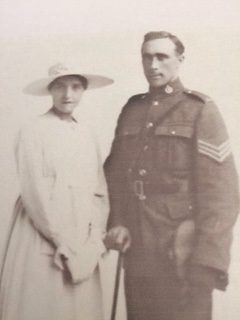Personal Details
Born: 12 February 1887 in Whitchurch, Shropshire and baptised on 6 August 1887 at St. Alkmund`s Parish Church, Whitchurch.
Family: He was the second of five children born to Walter Conway Joyce, a clock manufacturer and his wife Edith Mary, nee Wilkinson. He married Elsie Mary Plumb on 9 December 1917 at St. Mark`s Church, Lewisham, London. The couple had five children, Mary Alice, Sydney Thomas, Dorothy Madge, Nora Winnifred and Leslie.
Residence: At the time of his baptism and in 1891 his family were living in High Street, Whitchurch. In 1901 his mother was now widowed and the family had moved to 17 Edgeley Road, Whitchurch. Herbert emigrated to Canada in 1905 and was living in Liscar, Manitoba in 1911. This was the address he gave when he enlisted in 1915. By 1921 and now married he was living in King Street, Verdin, Brandon, Manitoba. At the time of his death his home was 502 Stewart Street, Winnipeg, Manitoba.
Employment: In 1911 he was a farmer and in 1921 he was a buttermaker.
Died: 9 August 1973 at Deer Lodge Hospital, Winnipeg, aged 86.
Military Details
Regiment: Canadian Expeditionary Force (Lord Strathcona`s Horse)
Rank: Sergeant
Service Number: 551029
Date of Enlistment: 20 August 1915
Date of Discharge: 9 February 1919
Reason for Discharge: Demobilisation
Other Information: Whilst serving in France he received a severe gunshot wound to his right thigh. His brother, Walter Dennis, also served in WW1.
Herbert was awarded the Campaign medals (Victory and British War Medals)

The British War Medal (also known as 'Squeak') was a silver or bronze medal awarded to officers and men of the British and Imperial Forces who either entered a theatre of war or entered service overseas between 5th August 1914 and 11th November 1918 inclusive. This was later extended to services in Russia, Siberia and some other areas in 1919 and 1920. Approximately 6.5 million British War Medals were issued. Approximately 6.4 million of these were the silver versions of this medal. Around 110,000 of a bronze version were issued mainly to Chinese, Maltese and Indian Labour Corps. The front (obv or obverse) of the medal depicts the head of George V. The recipient's service number, rank, name and unit was impressed on the rim.
The Allied Victory Medal (also known as 'Wilfred') was issued by each of the allies. It was decided that each of the allies should each issue their own bronze victory medal with a similar design, similar equivalent wording and identical ribbon. The British medal was designed by W. McMillan. The front depicts a winged classical figure representing victory. Approximately 5.7 million victory medals were issued. Interestingly, eligibility for this medal was more restrictive and not everyone who received the British War Medal ('Squeak') also received the Victory Medal ('Wilfred'). However, in general, all recipients of 'Wilfred' also received 'Squeak' and all recipients of The 1914 Star or The 1914/1915 Star (also known as 'Pip') also received both 'Squeak' and 'Wilfred'. The recipient's service number, rank, name and unit was impressed on the rim.

